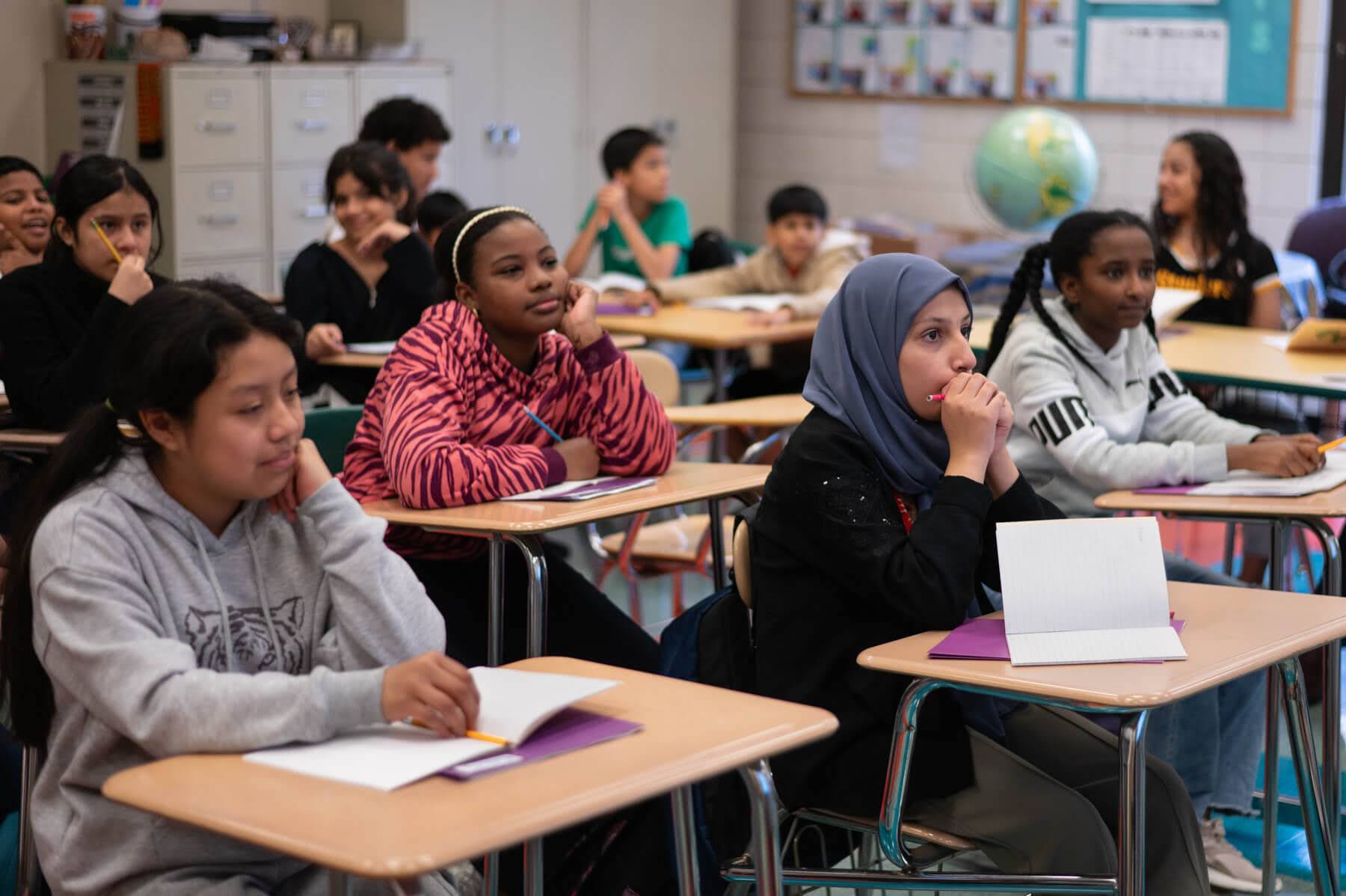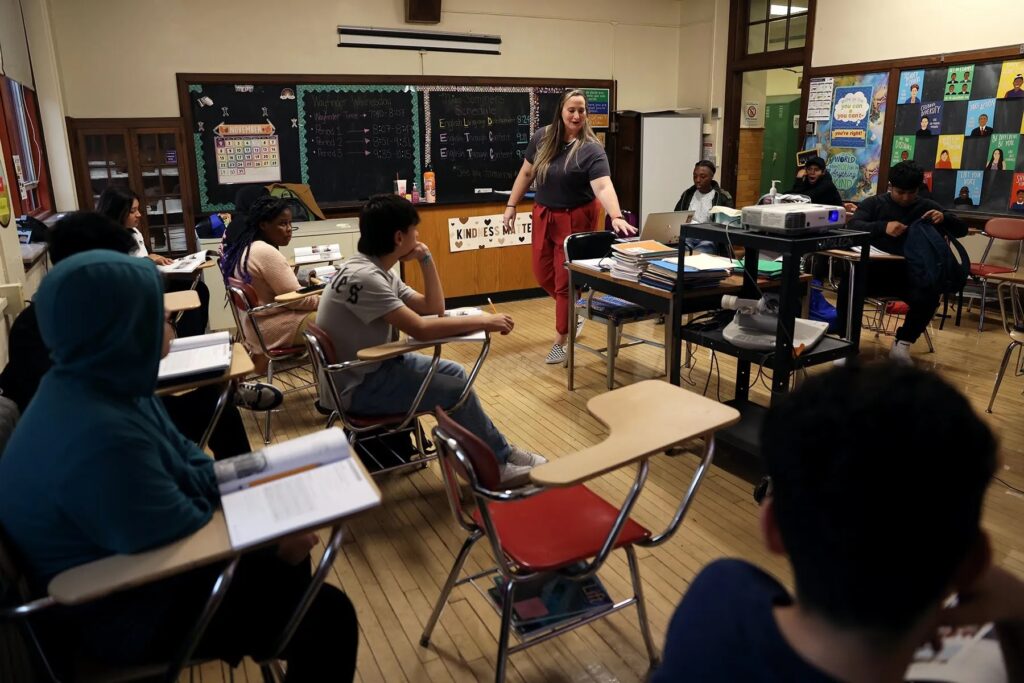
Megan Sommers projects her computer screen for her class of English language learners on Wednesday, Nov. 20, 2024, at Taylor Allderdice High School in Squirrel Hill. (Photo by Anastasia Busby/PublicSource)
Allderdice High School teacher Megan Sommers began her class by pulling up an image of a message in a bottle floating in the ocean.
“Looking at this picture, what would you do if you found this bottle?” she asked her class of about 20 students on a Thursday morning in November.
On another screen, Sommers opened Google Translate and proceeded to translate her question into Spanish, Russian, French, Ukrainian, Arabic, Thai and Turkish, one after the other.
She asked the question again, in English, prompting the students to answer. Her class is comprised of newcomer English Language Learner [ELL] students, who are new to the Pittsburgh Public Schools [PPS] and have little to no proficiency in English. Once students understand the question with the help of translation tools, Sommers urges them to write a few sentences in their worksheets.

Sommers always begins her classes with a creative writing prompt to help ELL students become more comfortable with the language.
“A lot of our students don’t ever get a chance to creatively write,” she said. “And oftentimes when I’ve talked to students about writing, it’s really hard to get them to write, and they hate to write, especially in English.”
Sommers has been an English Language Development [ELD] teacher in PPS for eight years. At the beginning of this school year, she was split between Allderdice High School and Westinghouse 6-12 as a part-time teacher to support a growing number of English learners in the classroom. Districtwide, the ELL student population grew by about 25% this year. Meanwhile, the district faces a shortage of ELD teachers, consistent with statewide and nationwide trends.
This year, the district has 53 language teachers and 18 multilingual classroom assistants to teach 1,800 English learners. But against that, there has been an influx of new students because of refugee resettlement and families moving to the city this year. Many of those students have no proficiency in English, which has posed challenges for the district’s staff.
Teaching math while also teaching English
Incoming PPS students who indicate a first language other than English are required to take a state-issued WIDA test to gauge their proficiency. Those deemed beginners are required to take two periods of language instruction during each school day.
Class sizes have increased this year because of an influx of beginner-level students who need to be pulled from general education English classes for language instruction.

At South Hills Middle School in Beechview, Ashley Haftl teaches math to a newcomer English learners class. Many of the students came from countries facing war or conflict such as Syria and Afghanistan, and did not receive any formal education prior to enrolling at South Hills. Some of those students had interrupted education and are several grade levels behind.
“When you have a class that’s 30 kids, it’s really challenging to meet the needs of all these students,” said Haftl. “I have students that know zero math ranging [up to] students who are at grade level.”
Nearly 40% of students at South Hills are English learners. This year, the school admitted about 40 new students, with the number still increasing.
Jonathan Covel, the ELD director at PPS, said more families have historically chosen to send their kids who aren’t native English speakers to the regional centers in which the district has concentrated the needed teaching resources. Allderdice and South Hills are two of 12 such centers in the district, and each has grown its share of English learners in recent years.
More students, fewer teachers
Increased class sizes are also partly due to a shortage of full-time English language development teachers in the district.
Like South Hills, Allderdice has recently swelled with English learners, enrolling 50 more this year for a total of 144.
Some schools with established English learner populations, including Brashear High School, have historically had more full-time ELD teachers for subjects like social studies and history.

Nationally, schools have failed to hire English learner teachers in step with the growing population of ELL students. Susan Rutledge, an ESL specialist program coordinator at Pennsylvania Western University, said there is a major shortage in certified specialists in that area. The State Department of Education issued only 1,895 certifications between 2015 and 2020 — far short of filling the need.
Jessica Porter has been a full-time ELD teacher at Allderdice for 12 years. Recently, Porter and her colleague, Michele Kelly, have advocated for more full-time ELD teachers to support the school’s growing non-native-English-speaking population.
“Why are we at over 100 kids, more than we’ve ever had before, and we have the same number of English teachers? It just wasn’t making sense,” said Porter.

Before the beginning of the school year, Porter and Kelly asked school leaders and district administration for another full-time ELD teacher but did not receive any confirmation until the end of summer when the district hired Sommers as a part-time teacher. A last-minute and part-time hire has felt like a “Band-Aid over a bullet hole,” they said.
Because of the teacher shortage, Porter said, the school had to modify classes and was unable to provide extra instruction for English learners other than one period of grade-level English.
“Classes are twice the size, so it’s just different,” said Porter. “So that has changed, just in terms of the level of support we can offer, because we’re kind of scrambling a little bit with the number of students that we have.”
Covel said the district approved multiple teaching positions last year to meet the needs of students and staff but acknowledges more are needed and that the district is currently reviewing their requests. He added that there have been more requests for translation and the district is trying to bring resources to schools that haven’t had high populations of English learners in the past.
The district’s collective bargaining agreement with the Pittsburgh Federation of Teachers [PFT] does not include any specifications for ELL students. A class for English learners can include up to 36 students, in line with traditional class size maximums.
PFT President Billy Hileman said English as a Second Language was part of the contract negotiations for the last several months but the union was unable to add any specified language such as a fixed student-teacher ratio in the upcoming contract.
“It does not mean that we won’t do the effort to build supports and guidelines and greater understanding and a more broad and deep program for English Language Learners that are now up to almost 10% of our student population,” he said.
Google Translate only goes so far
Outside of English learner classes, teachers in general education are also feeling the pressure of instructing a higher number of students who are still mastering the language.
Brian Calcagno, a social studies teacher and a soccer coach at South Hills, said it has been difficult to teach students in his class who do not speak any English. He coaches an all-ELL girls soccer team and a social studies class of 37 students, of which 30 are English learners.
While translation tools like Google Translate and Pocketalk are helpful, Calcagno said he needs more multilingual aides or paraprofessionals who can help him in his large classes.

The district’s shortage of paraprofessionals has been attributed to a residency requirement that mandates they live within the city to work in PPS. In the last year, the district organized successful hiring events to bring on more paraprofessionals.
ELD teachers in the district say that it would help if more teachers chose to get the certification that would allow them to support English learners. Teachers can earn an add-on certificate through the Allegheny Intermediate Unit or through universities. The district’s Lingua Pittsburgh program also has offered ESL Program Specialist certification to a cohort of teachers at a reduced cost in an effort to support the district’s growing English learner population.
Covel said finding teachers with the right credentials and multilingual paraprofessionals has been challenging.
“We’re looking to maximize our resources and effectively use those resources, so making sure that we’re looking closely at all of our data, making sure that we’re providing the appropriate amount of support,” he said.
Teachers want stability and support

At Allderdice, Sommers began the second half of her class by revising a story from the students’ brand-new textbook.
The story was about Kai, an immigrant student who was frustrated because he was having trouble understanding English in his math class.
“Kai used to love math. What made him feel good about the class?” Sommers asked, urging students to answer. Every now and then a student would ask her to translate her questions into their home language.
This year, PPS introduced National Geographic Lift textbooks, the first district-wide curriculum for newcomer English learner students. The textbooks include various fiction, non-fiction, audio-based, video-based and photo stories that are culturally relevant.
For some teachers, having a standardized curriculum this year has been helpful.
“That’s huge to even have a curriculum,” Porter said. “Just depending on what school you go to, if you are an English Language Learner in Pittsburgh, you’re getting a vastly different education.”

For other teachers like Kelly and Haftl, a new curriculum presented its own set of unique challenges.
Haftl teaches three different curriculums for three grade levels and often has to modify the language-heavy math texts for students who don’t speak English. Kelly — who is responsible for onboarding teachers, scheduling classes and screening students — said she did not get a chance to become used to the new curricula.
“All of that is in addition to my normal classroom obligations and it makes me very sad that my district, my administration, does not allow for what is required to do, what is best by my students,” Kelly said. “It’s very frustrating.”

Some teachers feel they’d face less pressure if the district had a Newcomer Academy, as suggested in a community proposal floated in response to the district’s Facilities Utilization Plan. Such an academy would aim to provide extended English language services for students with the highest needs. Covel wrote in response to questions that any move toward an academy would “need to be carefully analyzed.”
“I think anything that’s going to help our ESL students and bring a sense of equity to our ELD, I’m all in,” Sommers said.
This story was fact-checked by Jordana Rosenfeld.
This article first appeared on PublicSource and is republished here under a Creative Commons license.
PARSELY = { autotrack: false, onload: function() { PARSELY.beacon.trackPageView({ url: “https://www.publicsource.org/pittsburgh-public-schools-pps-ell-english-language-learners/”, urlref: window.location.href }); } }

